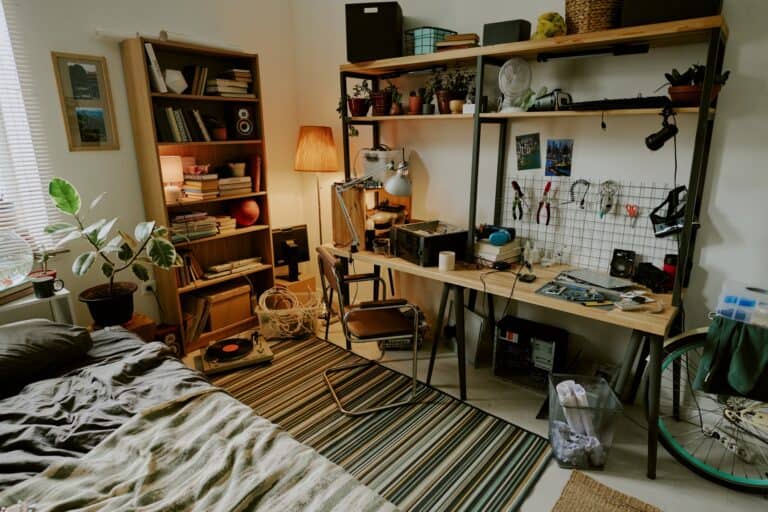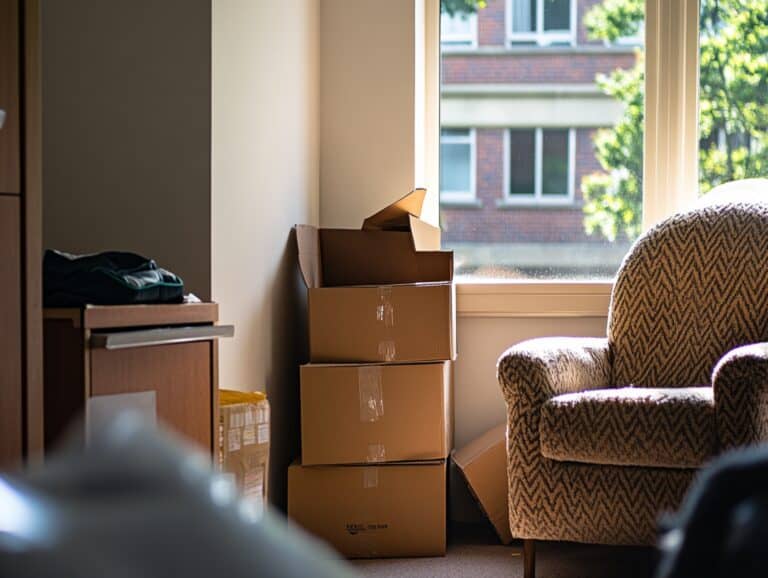Facing the challenge of how to move large furniture when moving house? Our comprehensive step-by-step guide provides essential tips to make the process smoother and less stressful. From careful planning and disassembling furniture to using practical tools like sliders and dollies, we’ve got you covered. Whether you’re tackling the move yourself or enlisting professional help, these strategies will ensure your heavy items are relocated efficiently and safely.
Key Takeaways
- Measure and disassemble large furniture to avoid headaches when fitting through doorways.
- Use ramps, furniture sliders, and dollies to move heavy items efficiently and safely.
- Plan furniture placement in your new home to save time and effort during the move.
Plan Ahead for a Stress-Free Move
The key to a stress-free move is starting early. By planning ahead, you’ll have ample time to manage logistics, coordinate with moving companies, and address any potential issues before they become major problems. Think of it as laying out a game plan for the big day. Removal companies in Lewisham can even visit your property beforehand to foresee possible problems and offer solutions, ensuring everything goes smoothly on a moving day.
In the weeks leading up to the move, create a meal plan to use up the contents of your fridge and freezer. This not only helps reduce waste but also ensures you don’t have to worry about transporting perishable items. Additionally, dismantle and pack away garden games and other outdoor items well in advance, especially when the kids aren’t around to get in the way.
By taking these steps, you’ll not only save time and money but also avoid potential delays and mishaps. A little planning goes a long way in making your house move as smoothly as possible.
Measure and Disassemble Large Furniture
Before you start hauling heavy furniture through doorways, take a moment to measure your pieces and the spaces they need to pass through. This simple step can prevent a lot of headaches down the road. Ensuring that your furniture will fit into your new designated spaces can save you from the frustration of finding out too late that your beloved sofa won’t fit through the front door.
If some pieces are too large or heavy to move as they are, disassemble them. This makes the furniture easier to manoeuvre and can even make the pieces lighter. Tools like screwdrivers, Allen keys, and hammers are usually all you need for disassembly. And in some cases, you might need to remove door stop mouldings or even door frames to create extra space.
Use Proper Lifting Techniques
Lifting heavy furniture incorrectly can lead to serious injuries, such as spinal compression and back strain. To avoid hurting yourself, always use proper lifting techniques. Start by testing your limitations and, if necessary, asking for help.
To move heavy furniture safely and efficiently, follow these simple guidelines:
- Kneel close to the object.
- Keep your core tight.
- Lift with your legs, not your back.
- Remember to breathe properly throughout the process, as holding your breath can deprive your brain of oxygen and make lifting more difficult.
By following these guidelines, you can move heavy furniture safely and efficiently without risking serious injuries.

Protect Your Furniture
When it comes to moving large furniture, protection is key. Use layers of protective materials like bubble wrap, blankets, and plastic film to guard your furniture during transit. For instance, wrap sofas in multiple moving blankets, seal them with strong tape, and cover them in plastic wrap to keep them safe.
To protect your furniture during a move, follow these steps:
- Wooden furniture should be tightly wrapped in blankets and then covered with bubble or plastic wrap for added protection.
- Mattresses can be protected by placing them inside a mattress bag and transporting them on their side.
- For TVs, tape the cords to the back, wrap them in blankets, and use cardboard to cushion the edges.
By following these steps to protect furniture, you can ensure that your furniture arrives at its new location in good condition.
Additionally, when moving furniture, make sure to:
- Secure loose components such as drawers or doors using plastic wrap
- Wrap furniture edges and corners with covers to provide extra padding
- Place sheets of cardboard on the corners and undersides to minimise damage from impact.
Clear Exit Pathways
Before you start moving furniture, ensure that all exit pathways are clear in both your old and new house. This not only reduces the time and effort required but also helps prevent damage to your furniture and walls. Keeping pathways clear on a moving day allows you to move furniture without the danger of tripping over obstacles during the moving house process.
Keeping pathways clear on a moving day allows you to move furniture without the danger of tripping over obstacles …
Inform your removals company about any difficult points of entry, narrow stairwells, or lack of on-site parking at your new house. This information can help them plan better and avoid potential complications during the move.
Utilise Furniture Sliders and Dollies
Furniture sliders and dollies are invaluable tools when moving heavy furniture. Here are some options to consider:
- Sliders: Small pieces of equipment made of plastic or rubber that are placed under each leg of large and heavy furniture, allowing you to slide the entire unit across a room effortlessly and without causing floor damage.
- Hard plastic sliders: Ideal for carpets.
- Felt sliders: Work well on hard surfaces like laminate or tile.
Furniture dollies, on the other hand, have four wheels and can withstand heavy loads, making the job easier and safer for everyone involved. A furniture dolly is a great alternative if you can’t find furniture sliders. In such cases, you can use:
- rugs
- towels
- plastic container lids
- Frisbees
as makeshift sliders. These simple tools can make a world of difference in the moving process.
Secure Loose Items
Before moving any piece of furniture, make sure to remove and secure any loose items inside. This not only prevents the furniture from becoming heavier but also avoids damaging the items inside during the move. Securing loose items helps keep drawers and doors shut, reducing the risk of breakage.
Use plastic wrap to secure drawers and doors, ensuring that nothing shifts during transport. This simple step can save you a lot of trouble and potential damage to your furniture and belongings.
Enlist Help from Friends or Professional Movers
Moving heavy furniture is often a two-person job, so don’t hesitate to ask for help. Some options for moving heavy furniture include:
- Asking friends or family members for assistance
- Hiring professional movers who provide moving insurance and have the experience to ensure a safe and efficient move
- Renting equipment such as dollies or furniture sliders to make the process easier and safer
Hiring experienced furniture movers can be the best way to move large and heavy objects, like furniture pieces, safely.
Alternatively, asking friends for help can significantly reduce moving costs and offer more flexibility. Plus, having friends around can make the moving process more enjoyable. Just be sure to consider the risks and ensure everyone is clear on the plan to avoid injuries and damage.
Protect Door Frames and Walls
Door frames and walls are particularly prone to damage during a move due to high traffic and movement. To prevent accidental damage, use sheets of thick cardboard and painter’s tape to protect the door frame and corridors. This simple step can save you from costly repairs and keep your new house in pristine condition.
For additional protection, consider using corner or doorway pads to keep doorframes chip-free. These precautions can go a long way in protecting your home and furniture.
Special Considerations for Moving Awkward Items

Moving awkwardly sized furniture and items requires special considerations. For kitchen appliances, make sure they are disconnected from power or gas supplies before moving and seek professional help if unsure. Dismantling a bed frame can make it easier to move, but larger mattresses often require at least two people.
Some tips for moving large items:
- Sofas may need their feet removed or an alternative route found if their dimensions don’t fit through doorways.
- Large, full-length mirrors should be wrapped and packed in specially padded boxes to ensure safe transport.
- For upright pianos, removing the legs can make moving easier, and they are typically narrow enough to fit through standard doorways.
Use Ramps for Stairs
Using ramps can significantly reduce the effort needed to move heavy furniture up or down stairs. Ramps allow heavy furniture to be rolled rather than lifted, minimising the risk of injury and damage. Ensure the ramp is long enough to accommodate the height being moved to prevent damage to both the ramp and the furniture.
You can create ramps using lumber, scaffold planks, and blocks, making the transition from home to van much easier. This simple tool can make a big difference in the moving process.
Load and Unload Strategically
When loading your belongings into the truck, follow these steps:
- Place heavy items like kitchen appliances at the bottom first to create a stable base.
- Move the big and heavy furniture next.
- Load the bulky pieces into the moving truck to complete the process.
- Use straps and ropes to secure items to the truck bed and prevent movement during transit.
Load bars can be installed across the width of the truck bed to help distribute weight and prevent items from shifting. Using dunnage like wood blocks or airbags to cushion items can also prevent damage during transit.
Plan Furniture Placement in the New House
Planning where your furniture will go in the new house can save you a lot of time and effort. Creating an unloading plan for large furniture pieces ensures that you won’t have to move them from room to room again. Consider traffic flow and ease of access to frequently used items to improve the functionality of a room.
Experimenting with different layouts can help create both an interesting and practical space. Don’t be afraid to swap furniture between rooms for a fresh look. This can help you make the most of your new property and ensure a comfortable and functional living space.
NOTE
Proper planning of furniture placement in your new home not only saves you time and effort but also enhances the functionality and comfort of your living space. By considering the traffic flow and ease of access to frequently used items, you can create a more efficient and enjoyable environment.
Summary
When moving large furniture, careful planning, proper tools, and assistance can make the process smoother and safer. Measure and disassemble furniture as needed to ensure it fits through doorways, use proper lifting techniques, and consider enlisting help from friends or professional movers. Protect the furniture with bubble wrap and blankets, clear exit pathways, and safeguard door frames and walls. These steps will help minimise damage and ensure a stress-free move.
Frequently Asked Questions
Why is it important to plan ahead for a move?
It’s important to plan ahead for a move because it allows for better logistics management and cost savings, and reduces stress by addressing potential issues before they arise. Moving can be overwhelming, so planning ahead can make the process smoother and less stressful.
How can I protect my furniture during a move?
Make sure to wrap your furniture in protective materials like bubble wrap and blankets, and secure loose parts to prevent damage during the move. Using corner guards and cardboard can provide extra padding for added protection.
What are some tips for moving heavy furniture upstairs?
Use ramps to roll heavy furniture up or down stairs to reduce the need for lifting and prevent potential damage. It makes the process much easier and safer.
Should I hire professional movers or ask friends for help?
Hiring professional movers is a safer and more efficient option, as they provide insurance and have experience, ensuring a smooth move. Asking friends for help can reduce costs, but may increase the risk of injuries and damage. Choose the option that best fits your needs and budget.
How can I ensure a smooth moving day?
To ensure a smooth moving day, make sure to clear exit pathways, measure and disassemble large furniture, use proper lifting techniques, and enlist help from friends or professional movers in Lewisham. Planning ahead and protecting your furniture and door frames are also crucial. Good luck on your moving day!







